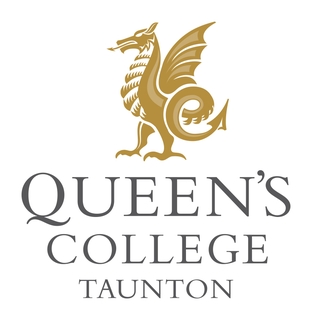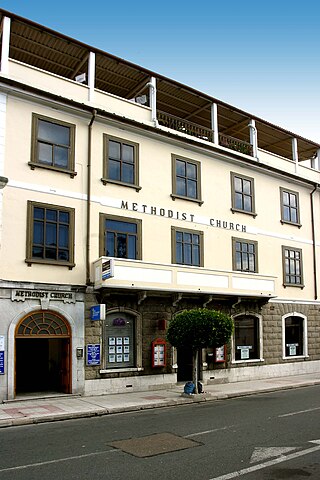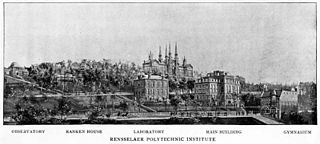History
Wesleyan-Methodist Academy opened in 1860 on Longs Hill. It was a wooden building.
In 1874 the name Wesleyan-Academy changed to Methodist Academy when the Newfoundland Conference of the Methodist Church of Canada was formed. It was administered by a Board of Directors.
1886 a major expansion and reconstruction program to the building, adding a Model school (teacher training) and a students’ residence (the College Home). The Academy was now reconstituted as the Methodist College, and the Board of Directors was replaced by a Board of Governors. The College was formally known as “The Newfoundland Methodist College”.
The entire complex was destroyed in the Great Fire of July 1892.
In 1894 a new, much larger building was erected on the site, as well as a new College Home.
Edward, Prince of Wales (later King Edward VIII) was visiting Newfoundland in 1919 and laid the corner stone for the proposed new Methodist College—later named Prince of Wales College.
In January 1925, just six months before it would have become the United Church College (in keeping with Church Union in June of that year), the building, like its predecessor, fell victim to fire. The main structure of the building was salvaged.
1926 a new building was built from the old and named Holloway School, in honor of Robert Holloway, former principal of the Methodist College.
In 1928 Prince of Wales College on LeMarchant Road opened as a secondary school and Holloway School became an elementary school.
Harrington School opened in 1956, due to increased enrollment, and accommodated kindergarten and grade one.
Circa 1957, again due to a lack of space, Prince of Wales Annex on LeMarchant Road opened for Grade six.
In 1960, the present building on Paton Street opened as The United Church Regional High School, United Collegiate. The students came from Macpherson and Curtis Academy in that first year. The school was renamed Prince of Wales Collegiate in 1963.

The Royal Military College (RMC), founded in 1801 and established in 1802 at Great Marlow and High Wycombe in Buckinghamshire, England, but moved in October 1812 to Sandhurst, Berkshire, was a British Army military academy for training infantry and cavalry officers of the British and Indian Armies.

Roberts Wesleyan University is a private Christian university offering liberal arts and professional programs in Rochester, New York. It was the first educational institution established for Free Methodists in North America. Roberts is accredited by the Middle States Commission on Higher Education, is a member of the Association of Colleges and Universities of the State of New York, the Rochester Area Colleges, the Association of Free Methodist Educational Institutions, the Council of Independent Colleges (CIC), and the Council for Christian Colleges and Universities (CCCU).

Sutton-in-Ashfield is a market town in Nottinghamshire, England, with a population of 48,527 in 2019. It is the largest town in the district of Ashfield, four miles west of Mansfield, two miles from the Derbyshire border and 12 miles north of Nottingham.

Virginia Wesleyan University (VWU) is a private university in Virginia Beach, Virginia. The university is nonsectarian but historically affiliated with The United Methodist Church. It enrolls 1,607 students annually in undergraduate and graduate programs, 355 students at LUJ/VWU Global (Japan), and 1,403 in VWU Online. Virginia Wesleyan transitioned from a college to a university in 2017.

Carbonear is a town on the Avalon Peninsula in Newfoundland and Labrador, Canada. It overlooks the west side of Conception Bay and had a history long tied to fishing and shipbuilding. Since the late 20th century, its economy has changed to emphasize education, health care, retail, and industry. As of 2021, there were 4,696 people in the community.

Queen's College is a co-educational independent school located in Taunton, the county town of Somerset, England. It is a day/boarding school for pupils aged 0–18. The school incorporates nursery, pre-prep, Prep, and senior schools. The current Head of College is Julian Noad. Henry Matthews is headmaster of Queen's College Prep School.

Albert College is a co-educational independent boarding and day school located in Belleville, Ontario, Canada. It is the oldest co-ed boarding independent school in Canada, and the only private boarding school in Belleville. Albert College currently has an enrolment of approximately 300 students from over 20 countries. The school comprises an Early Primary Learning Centre (Pre-Kindergarten), a Junior School, a Middle School, and a Senior School.

St. Mary of the Plains College was a four-year liberal arts college in Dodge City, Kansas, United States that closed in 1992.
The Eastern School District of Newfoundland and Labrador (ESDNL) was the de facto school board for the eastern portion of the island of Newfoundland, in the Canadian province of Newfoundland and Labrador. Its headquarters was in St. John's and there were regional offices in Spaniard's Bay, Burin and Clarenville. The district served approximately 40,000 students with 4,200 staff and teachers. It was amalgamated in 2013 into the Newfoundland and Labrador English School District.

Stanstead College is an English-language independent boarding school in Stanstead, Quebec, Canada, for boys and girls in Grades 7 through 12. The school is located on a 600-acre (2.4 km2) campus in Quebec's Eastern Townships – just north of the Canada–United States border – and enrolls approximately 265 students.

St. Oscar Romero Catholic Secondary School is a Catholic high school in Toronto, Ontario, Canada. It operated as Archbishop Romero Catholic Secondary School until 2015 and Blessed Archbishop Romero Catholic Secondary School until 2018. The school is a member of the Toronto Catholic District School Board, formerly the Metropolitan Separate School Board and is named after Salvadoran archbishop Oscar Romero, who was assassinated in 1980. The school building was opened in 1967 as York Humber High School by the Board of Education for the City of York, later the Toronto District School Board. It has been leased to the MSSB/TCDSB since 1989. St. Oscar Romero's school motto is "Community, Justice, and Knowledge".

The Gibraltar Methodist Church is part of the South East District of the Methodist Church of Great Britain. It has a long history associated with the development of British Gibraltar, and it has greatly strengthened its ties with the local population since the scaling down of Britain-based forces in recent years. In 2006 it appointed Fidel Patron - the first Gibraltarian Superintendent Minister.

Llanfechain is a village and community in Powys, Wales, on the B4393 road between Llanfyllin and Llansantffraid-ym-Mechain. Historically it belonged to Montgomeryshire. The River Cain runs through. The population of 465 at the 2011 Census was estimated at 476 in 2019.

Troy University was a short-lived university established at Troy, New York in 1858 under the auspices of the Methodist Episcopal Church. The school closed in 1861. The building that housed the university remained a prominent Troy landmark until 1969. On the site now is Rensselaer Polytechnic Institute's Folsom Library.
Bishops College was a high school located in central St. John's, Newfoundland and Labrador. It was next to another high school called Booth Memorial High.
The Wesleyan Methodist Church was the majority Methodist movement in England following its split from the Church of England after the death of John Wesley and the appearance of parallel Methodist movements. The word Wesleyan in the title differentiated it from the Welsh Calvinistic Methodists and from the Primitive Methodist movement, which separated from the Wesleyans in 1807. The Wesleyan Methodist Church followed the Wesleys in holding to an Arminian theology, in contrast to the Calvinism held by George Whitefield, by Selina Hastings, and by Howell Harris and Daniel Rowland, the pioneers of Welsh Methodism. Its Conference was also the legal successor to John Wesley as holder of the property of the original Methodist societies.

Bishop Feild College, founded in 1844, is a school in St. John's, Newfoundland. Founded as the Church of England Academy, it was renamed in 1892 as the Church of England College in 1892, before its 1894 name change to Bishop Feild College. The renaming was in honor of Bishop Edward Feild, a school inspector and second bishop of Newfoundland.

Burnley, in Lancashire, England, has a long history of religious worship, dating from at least before 1122 in the case of the Church of England. The chapel at Towneley Hall was the centre for Roman Catholic worship in Burnley until modern times. Well before the Industrial Revolution, the town saw the emergence of many non-conformist churches and chapels. In 1891 the town was the location of the meeting which saw the creation of the Baptist Union of Great Britain and Ireland. In the late 19th century a Jewish synagogue was established, and in recent times evangelical and free churches have appeared, as well as a large purpose-built mosque.
Elijah Hoole was an English architect of Methodist churches, settlement halls and social housing. In relation to the social housing, he worked closely with the social reformer Octavia Hill for over 40 years.















